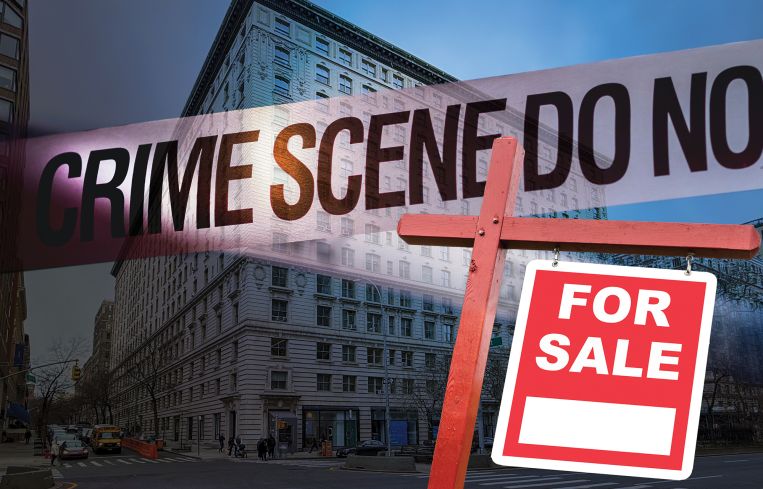Only Murders in Your Building? Here’s How to Sell Units Anyway.
Brokers and marketers dish on hypothetical approaches to selling New York condos and co-ops with notorious histories
By Amanda Schiavo October 28, 2025 10:35 am
reprints
Imagine being the broker for a luxury residential building, and every year over the course of five years there has been a high-profile murder at that property that would become the subject of a popular true crime podcast hosted by a trio of building residents.
That’s the plotline of Hulu’s “Only Murders in the Building,” starring Selena Gomez, Martin Short and Steve Martin.
Somehow this fictional building called the Arconia (portrayed on screen by the real-life Belnord) hasn’t been closed down or sold off — although that might change this season, since the main characters are up against some unscrupulous billionaires who want to convert the co-op building into New York City’s first-ever casino. (Imagine conversions that leave us with less housing — those are well-written villains right there!)
Even more unclear is why three people who seem to be a magnet for murders haven’t been kicked out yet — especially since brokers agree that other Arconia owners could come together to facilitate a board hearing to force them out. In any case, when it comes to the Arconia, it is arguably safe to assume that every year for the foreseeable future there will be at least one unit that is back on the market and in need of a new resident.
With that in mind, let’s pull the Arconia off the screen and into the real world, shall we?
Imagine being the broker for this building. How would you even begin to market and sell a unit here? Perhaps the broker should dangle the carrot of bullet-resistant windows and the installation of a biometric lock? Just a thought.
Brock Emmetsberger, executive vice president of multifamily at Matthews, has some suggestions for the broker tasked with selling in a real-life Arconia. Though Emmetsberger focuses on commercial real estate and would defer to the expertise of residential brokers, he’s had some experience selling residential property with a ghoulish past.
In 2010, Emmetsberger sold 31 Bond Street, the site of one of Manhattan’s most notorious 19th-century crimes, the murder of Dr. Harvey Burdell. The doctor’s sensational murder and the trial of accused killer Emma Cunningham reached a fever pitch at the time — think O.J. Simpson or Jodi Arias levels of attention.
Though the murder wasn’t something Emmetsberger used to hook the attention of potential buyers, they would occasionally bring up the incident on their own, taking an interest in the building’s murderous past, and becoming intrigued by the grisly history.
“It was woven into the history, as opposed to an event that’s negatively affecting the real estate on the day to day,” Emmetsberger said of 31 Bond Street. “It would be a huge difference whether a crime took place in the property shortly before marketing it versus a nefarious act that took place years before.”
That being said, Emmetsberger is still confident he’d be able to sell a unit at the Arconia given the opportunity.
“The ‘Only Murders in the Building’ setting is very loosely based on the Belnord and Ansonia, very classic Upper West Side apartment buildings,” Emmetsberger said. “They are some of the more prominent residential landmarks in New York City. So that, by itself, even if there is a murder every year, there are people just wanting to be in those buildings. It’s a dream of theirs. So, fortunately, if your real estate is that good, it tends to overcome a lot.”
Emmetsberger’s strategy to sell in a notorious building like the Arconia would be to highlight the building’s assets and amenities, focusing on the benefits of living there versus the odds of being its next victim.
Another area to draw buyers’ attention would be to the building’s long history in New York City.
According to the show, the Arconia was built in 1908. If it were real, it would have existed through some of the most significant historical events in New York City, including the development of most of the subway as well as the region’s airports, never mind the construction of iconic skyscrapers like the Empire State and Chrysler buildings — plus world-changing events like the market crash of 1929 and the Great Depression afterward.
“I would continue focusing on that property’s history, its benefits, it being a landmark, and focusing on that pool of buyers that just always wanted to live in the building,” Emmetsberger said. “Nothing’s going to scare them away from fulfilling that dream.”
Another approach to a sale at the Arconia would be to lean all the way into what’s been happening over the past five years — don’t let the potential buyers find out on their own — and jump into a pool of clients who might be a bit fascinated by the disturbing and the macabre.
“I mean, calling all psychos,” said Leonard Steinberg, the self-described “chief evangelist” and corporate broker at Compass. “There are few people in the world who don’t enjoy a murder mystery, who probably are quite intrigued by the subject matter and don’t take it seriously, as if they’re going to be murdered the next day. For some it will be a total turn-off, 100 percent, there’s no question. And, for others, I think it’ll be maybe not amusing, but at least interesting.”
Steinberg’s strategy for the Arconia would be to take a softer approach to the situation, not getting too dark about what had been going on, and to just be realistic about New York City as a whole.
“The role of the agent is to maximize value,” he said. “And, bottom line, probably everyone buying an apartment in New York is probably standing on ground where some horrible murder took place at some point in history. So paranoia around [the Arconia] is probably a little misguided when you look at the bigger picture.”
Steinberg isn’t wrong about the realities of city life. Some of New York’s most beautiful residences have ugly histories of murderous violence, yet are still sought-after co-op or condo buildings. So, if the Arconia were real, the murders wouldn’t exactly make its units unsellable.
So let’s return to that fictional Upper West Side landmark.
Vickey Barron, a residential broker with Compass, said given the choice she would probably pass on selling in the Arconia. But if she had to sell a unit there, she would tell the truth upfront, focus on buyers who are more logical thinkers — doctors, bankers, lawyers, scientists — and use humor to defuse the situation.
“I would start off by asking the client ‘Do you lock your doors at night?’ ” she said. “Make humor and disclose upfront. I would say, ‘Well, you look like you’ve had a good life.’ My approach would be facts and humor.”
Any broker worth their salt will tell you a strong listing description can help get potential buyers interested. And a unit in the Arconia would need one heck of an intriguing write-up. Thankfully, David Rosen of the Rosen Team at SERHANT was kind enough to come up with a sample description — where he played on some famous designer names — for a unit there.
The most significant address on the Upper West Side, Unit 643 is a newly cleaned and upgraded flat that absolutely kills. The sellers are motivated and have redone the counters with blood red and gold marble. New detachable brass sconces adorn the moth-wing texture wallpaper by Farrow & Hel. Designed by Roger P.M. Burn, the Arconia is the place to see, and not be seen. Notable for prewar details and at-war action, the doormen are committed to their posts, and the board is heavily invested in the life and death of this notable landmark.
“You can’t hide five murders in five years! So you have to find the super successful person who is too jaded to care and also somewhat turned on by the excitement,” Rosen said. “The thing about voyeurs or macabre sensations is that the fantasy is better than the reality. So you still want luxury and safety. You just have to wrap it in intrigue.”
Amanda Schiavo can be reached at aschiavo@commercialobserver.com.



